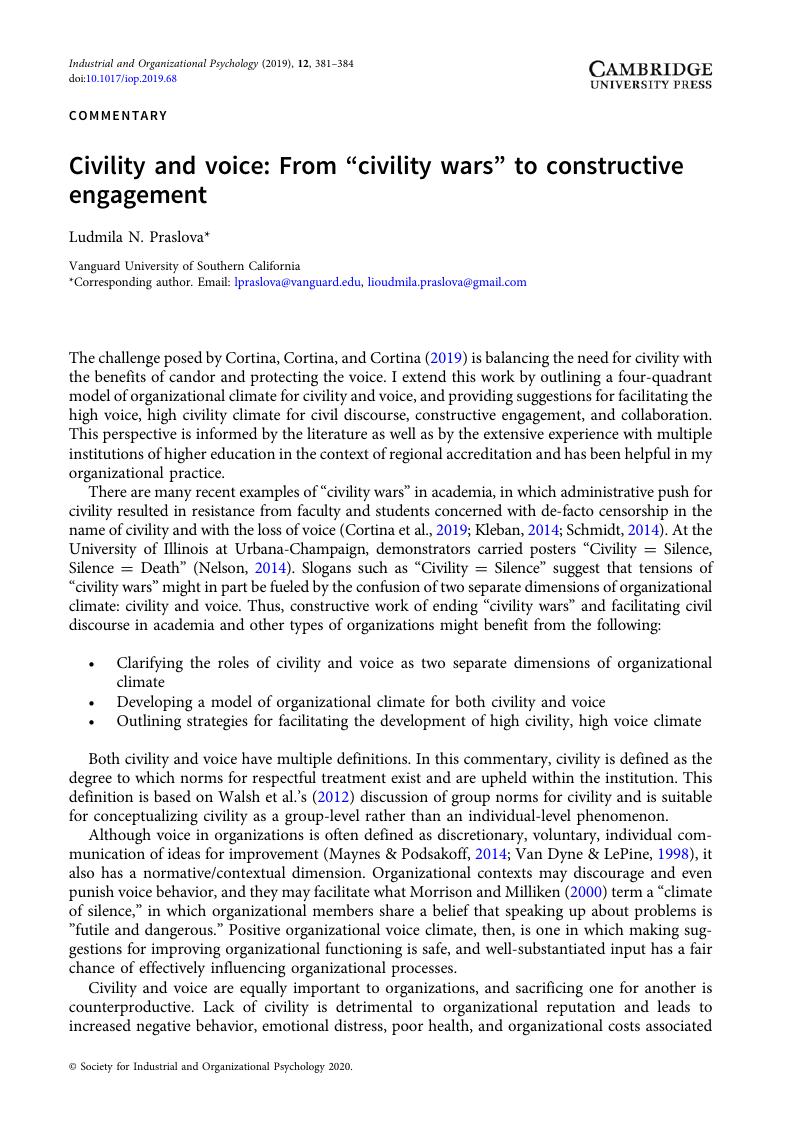No CrossRef data available.
Article contents
Civility and voice: From “civility wars” to constructive engagement
Published online by Cambridge University Press: 14 January 2020
Abstract
An abstract is not available for this content so a preview has been provided. Please use the Get access link above for information on how to access this content.

- Type
- Commentaries
- Information
- Copyright
- © Society for Industrial and Organizational Psychology 2020
References
Adams, G., & Webster, J. (2013). Emotional regulation as a mediator between interpersonal mistreatment and distress. European Journal of Work and Organizational Psychology, 22(6), 697–710.CrossRefGoogle Scholar
Cameron, A., & Webster, J. (2011). Relational outcomes of multicommunicating: Integrating incivility and social exchange perspectives. Organization Science, 22(3), 754–771.CrossRefGoogle Scholar
Cortina, L. M., Cortina, M. G., & Cortina, J. M. (2019). Regulating rude: Tensions between free speech and civility in academic employment. Industrial and Organizational Psychology: Perspectives on Science and Practice, 12(4), 357–375.Google Scholar
Fast, N. J., Burris, E. R., & Bartel, C. A. (2014). Managing to stay in the dark: Managerial self-efficacy, ego defensiveness, and the aversion to employee voice. Academy of Management Journal, 57(4), 1013–1034.CrossRefGoogle Scholar
Kleban, P. (2014, September 8). Is call for civility meant to silence critics? Retrieved from http://www.statecollege.com/news/columns/is-call-for-civility-meant-to-silence-critics,1460732/Google Scholar
Lim, S., Cortina, L., & Magley, V. (2008). Personal and workgroup incivility: Impact on work and health outcomes. Journal of Applied Psychology, 93(1), 95–107.CrossRefGoogle ScholarPubMed
Meier, L., & Spector, P. (2013). Reciprocal effects of work stressors and counterproductive work behavior: A five-wave longitudinal study. Journal of Applied Psychology, 98(3), 529–539.CrossRefGoogle ScholarPubMed
Maynes, T. D., & Podsakoff, P. M. (2014). Speaking more broadly: An examination of the nature, antecedents, and consequences of an expanded set of employee voice behaviors. Journal of Applied Psychology, 99(1), 87–112.CrossRefGoogle ScholarPubMed
McClean, E., Burris, E. R., & Detert, J. R. 2013. When does voice lead to exit? It depends on leadership. Academy of Management Journal, 56(2), 525–548.CrossRefGoogle Scholar
Morrison, E. W. (2011). Employee voice behavior: Integration and directions for future research. The Academy of Management Annals, 5(1), 373–412.CrossRefGoogle Scholar
Morrison, E. W., & Milliken, F. J. (2000). Organizational silence: A barrier to change and development in a pluralistic world. Academy of Management Review, 25, 706–725.CrossRefGoogle Scholar
Neal, A., & Griffin, M. A. (2006). A study of the lagged relationships among safety climate, safety motivation, safety behavior, and accidents at the individual and group levels. Journal of Applied Psychology, 91(4), 946–953.CrossRefGoogle ScholarPubMed
Nelson. (2014). A civility manifesto. Inside Higher Ed. Retrieved from https://www.insidehighered.com/views/2014/10/10/essay-defending-value-civility-higher-educationGoogle Scholar
Pearson, C., & Porath, C. (2005). On the nature, consequences and remedies of workplace incivility: No time for “nice”? Think again. Academy of Management Executive, 19(1), 7–18.Google Scholar
Pearson, C., & Porath, C. (2009). The cost of bad behavior. Organizational Dynamics, 39, 64–71.Google Scholar
Schmidt, P. (2014). Pleas for civility meet cynicism. Chronicle of Higher Education. Retrieved from http://chronicle.com/article/Pleas-for-Civility-Meet/148715/Google Scholar
Tindel, K. (2014). Uncontainable: How passion, commitment, and conscious capitalism built a business where everyone thrives. New York, NY: Grand Central Publishing.Google Scholar
Tucker, S., & Turner, N. (2015). Sometimes it hurts when supervisors don’t listen: The antecedents and consequences of safety voice among young workers. Journal of Occupational Health Psychology, 20(1), 72–81.CrossRefGoogle ScholarPubMed
Van Dyne, L., & LePine, J. A. (1998). Helping and voice extra-role behaviors: Evidence of construct and predictive validity. Academy of Management Journal, 41, 108–119.Google Scholar
Walsh, B. M., Magley, V. J., Reeves, D. W., Davies-Schrils, K. A., Marmet, M., & Gallus, J. A. (2012). Assessing workgroup norms for civility: The development of the Civility Norms Questionnaire–Brief. Journal of Business and Psychology, 27, 407–420.CrossRefGoogle Scholar
Zapata-Phelan, C., Colquitt, J., Scott, B., & Livingston, B. A. (2009). Procedural justice, interactional justice, and task performance: The mediating role of intrinsic motivation. Organizational Behavior and Human Decision Processes, 108, 93–105.CrossRefGoogle Scholar




